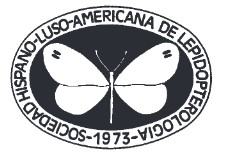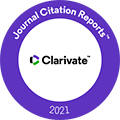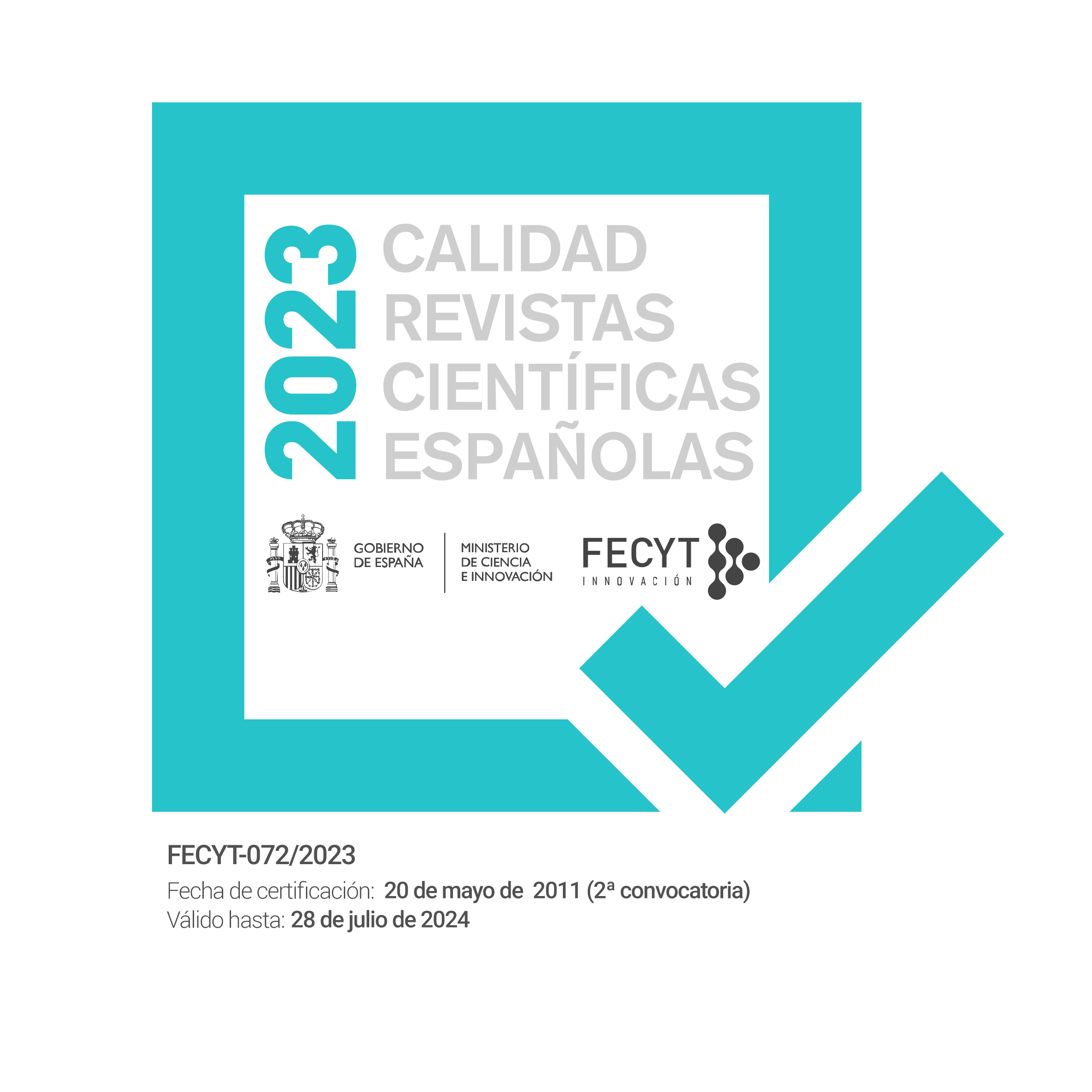Estimation of the potential habitat for Satyrium w-album (Knoch, 1782) in the Iberian Peninsula and prediction of the climate change effects on its distribution for the years 2050 and 2070 (Lepidoptera: Lycaenidae)
DOI:
https://doi.org/10.57065/shilap.729Keywords:
Lepidoptera, Lycaenidae, Satyrium w-album, distribution model, MaxEnt, climate change, Iberian PeninsulaAbstract
In this paper we try to increase the knowledge of possible distribution of Satyrium w-album in the Iberian Peninsula using the predictive model MaxEnt, estimated the potential of habitat for this species under current bioclimatic conditions, in addition to estimate the future potential of habitat under the climate change effects for the years 2050 and 2070 used two scenarios of possible emission (RCP 4.5 and RCP 8.5). The results show a tendency to reduce those grids with high habitat potentiality (=0.55-1) for both periods and emission scenarios. This reduction was more pronounced for the year 2070 under the RCP 8.5, leaving those grids with a high potentiality relegated to areas with a high altitude.
Downloads
Global Statistics ℹ️
|
185
Views
|
143
Downloads
|
|
328
Total
|
|
References
AGUADO, L. O., FERERES, A. & VIÑUELA, E., 2017.– Guía de campo de los polinizadores de España: 340 pp. Ediciones Mundi-Prensa, Madrid.
ARAÚJO, M. B. & LUOTO, M., 2007.– The importance of biotic interactions for modelling species distributions under climate change.– Global Ecology and Biogeography, 16(6): 743-753. DOI: https://doi.org/10.1111/j.1466-8238.2007.00359.x
ARAÚJO, M. B., PEARSON, R. G., THUILLER, W. & ERHARD, M., 2005.– Validation of species-climate impact models under climate change.– Global Change Biology, 11: 1504-1513. DOI: https://doi.org/10.1111/j.1365-2486.2005.01000.x
BOYCE, M. S., VERNIER, P. R., NIELSEN, S. E. & SCHMIEGELOW, F. K. A., 2002.– Evaluating resource selection functions.– Ecological Modelling, 157(2-3): 281-300. DOI: https://doi.org/10.1016/S0304-3800(02)00200-4
COLLIN, E., 2003.– Euforgen technical guidelines for genetic conservation and use for European white elm (Ulmus laevis). International Plant Genetic Resources Institute. Rome.
COLLIN, E., BILGER, I., ERIKSSON, G. & TUROK, J., 2000.– The conservation of Elm Genetic Resources in Europe.– The Elms: 281-293. DOI: https://doi.org/10.1007/978-1-4615-4507-1_18
DE LUIS, M., BRUNETTI, M., GONZÁLEZ-HIDALGO, J. C., LONGARES, L. A. & MARTÍN-VIDE, J., 2010.– Changes in seasonal precipitation in the Iberian Peninsula during 1946-2005.– Global and Planetary Change, 74(1): 27-33. DOI: https://doi.org/10.1016/j.gloplacha.2010.06.006
DENNIS, R. L., 1993.– Butterflies and Climate Change: 276 pp. Manchester University Press, Manchester.
DENNIS, R. L., DAPPORTO, L., DOVER, J. W. & SHREEVE, T. G., 2013.– Corridors and barriers in biodiversity conservation: A novel resource-based habitat perspective for butterflies.– Biodiversity and Conservation, 22: 2709-2734. DOI: https://doi.org/10.1007/s10531-013-0540-2
DENNIS, R. L. H., HODGSON, J. G., GRENYER, R., SHREEVE, T. G. & ROY, D. B., 2004.– Host plants and butterfly biology. Do host-plant strategies drive butterfly status?- Ecological Entomology, 29(1): 12-26. DOI: https://doi.org/10.1111/j.1365-2311.2004.00572.x
DIAMOND, S. E., FRAME, A. M., MARTÍN, R. A. & BUCKLEY, L. B., 2011.– Species’ traits predict phenological responses to climate change in butterflies.– Ecology, 92(5): 1005-1012. DOI: https://doi.org/10.1890/10-1594.1
DÍAZ, G., GALLEGO, D., GUTIÉRREZ, A., MUSALY, A., SORIANO, E. & GALIÁN, J., 2009.– Caracterización morfológica, fisiológica y molecular de nuevos aislados de Ophiostoma novo-ulmi.– Boletín de Sanidad Vegetal. Plagas, 35: 469-479.
DUNNE, J. P., STOUFFER, R. J. & JOHN, J. G., 2013.– Reductions in labour capacity from heat stress under climate warming.– Nature Climate Change, 3(6): 563-566. DOI: https://doi.org/10.1038/nclimate1827
ESRI, 2015.– ArcGIS, version 10.4. Environmental System Research Institute, Redlands, CA.
FIELDING, A. H. & BELL, J. F., 1997.– A review of methods for the assessment of prediction errors in conservation presence/absence models.– Environmental Conservation, 24(1): 38-49. DOI: https://doi.org/10.1017/S0376892997000088
FORSTER, P. M., ANDREWS, T., GOOD, P., GREGORY, J. M., JACKSON, L. S. & ZELINKA, M., 2013.– Evaluating adjusted forcing and model spread for historical and future scenarios in the CMIP5 generation of climate models.– Journal of Geophysical Research: Atmospheres, 118: 1139-1150. DOI: https://doi.org/10.1002/jgrd.50174
FOX, R., WARREN, M. S., ROY, D. B., BRERETON, T. M. & ROBINSON, A., 2011.– A new Red List of British butterflies.– Insect Conservation and Diversity, 4: 159-172. DOI: https://doi.org/10.1111/j.1752-4598.2010.00117.x
GARCÍA-BARROS, E., MUNGUIRA, M., MARTÍN-CANO, J., ROMO-BENITO, H., GARCÍA-PEREIRA, P. & MARAVALHAS, E. S., 2004.– Atlas de las mariposas diurnas de la Península Ibérica e islas Baleares (Lepidoptera: Papilionoidea & Hesperioidea).– Monografías de la S.E.A., 11: 1-228.
GÓMEZ-S., R., 2006.– Plan de manejo propuesto para la cría de mariposas promisorias como alternativa productiva para comunidades indígenas de la Amazonia colombiana.– Boletín de la Sociedad Entomológica Aragonesa, 38: 451-460.
GONZÁLEZ-FERNÁNDEZ, J., 2008.– Algunas citas extemporáneas o poco habituales de ropalóceros de Asturias (Lepidoptera: Papilionoidea & Hesperioidea).– Boletín de la Sociedad Entomológica Aragonesa, 42: 453-454.
HEIKKINEN, R. K., LUOTO, M., LEIKOLA, N., PÖYRY, J., SETTELE, J., KUDRNA, O., MARMION, M., FRONZEK, E. & THUILLER, W., 2010.– Assessing the vulnerability of European butterflies to climate change using multiple criteria.– Biodiversity and Conservation, 19(3): 695-723. DOI: https://doi.org/10.1007/s10531-009-9728-x
HIJMANS, R. J., CAMERON, S. E., PARRA, J. L., JONES, G. & JARVIS, A., 2005.– Very high resolution, interpolated climate surfaces for global land areas.– International Journal of Climatology, 25: 1965-1978. DOI: https://doi.org/10.1002/joc.1276
IPCC., 2014.– Climate Change 2014: Synthesis Report. Contribution of Working Groups I, II and III to the Fifth Assessment Report of the Intergovernmental Panel on Climate Change: 151 pp. Geneva, Switzerland.
KONVICKA, M., MARADOVA, M., BENES, J., FRIC, Z. & KEPKA, P., 2003.– Uphill shifts in distribution of butterflies in the Czech Republic: Effects of changing climate detected on a regional scale.– Global Ecology and Biogeography, 12(5): 403-410. DOI: https://doi.org/10.1046/j.1466-822X.2003.00053.x
LATASSA-ASSO, T., 1999.– Actualización de la distribución geográfica de los lepidópteros ropalóceros de La Rioja (España) (Insecta: Lepidoptera).– ZUBIA. Monográfico, 11: 11-60.
LÓPEZ, C. & PINO, J. J., 1992b.– Confirmación de la presencia de Erebia euryale (Esper, 1805) en Lugo y primera cita para Galicia de Strymonidia w-album (Knoch, 1782).– SHILAP Revista de lepidoterología, 20(80): 405-406.
MAXENT (https://biodiversityinformatics.amnh.org/open_source/maxent/)
MEROW, C., SMITH, M. J. & SILANDER, J. A., 2013.– A practical guide to MaxEnt for modeling species’distributions: what it does, and why inputs and settings matter.– Ecography, 36: 1058-1069. DOI: https://doi.org/10.1111/j.1600-0587.2013.07872.x
MILLER, R., 2015.– The Trees and Woodland of Abney Park Cemetery.– The London Naturalist, 87: 1-24.
MIRANDA-SIERRA, C. A., GEADA-LÓPEZ, G. & SOTOLONGO-SOSPEDRA, R., 2017.– Modelación de hábitats potenciales de Pinus caribaea Morelet var. caribaea Barrett y Golfari en el occidente de Cuba.– Avances, 19(1): 42-50.
MORTERA-PIORNO, H., 2007.– Mariposas de Asturias: 241 pp. Gobierno del Principado de Asturias, Oviedo.
MUNGUIRA, M. L., GARCÍA-BARROS, E. & MARTÍN, J., 1997.– Plantas nutricias de los licénidos y satirinos españoles (Lepidoptera?: Lycaenidae y Nymphalidae).– Boletín Asociación Española de Entomología, 21(1-2): 29-53.
MURRIA-BELTRÁN, E., 2009.– Presencia de Apatura iris (Linnaeus, 1758) (Nymphalidae, Apaturinae) en el pirineo central de Huesca, nuevos registros de Danaus chrysippus (Linnaeus, 1758) (Nymphalidae, Danainae) del valle medio del Ebro, y otros datos de interés para el conocimiento de los Papilionoidea de Aragón (España) (Lepidoptera).– Boletín de la Sociedad Entomológica Aragonesa, 45: 335-342.
NAVARRO, C. & CASTROVIEJO, S., 2005.– Ulmus L.– Flora Iberica, 3: 245-247 pp. Real Jardín Botánico, CSIC,
Madrid.
NEWBOLD, T., GILBERT, F., ZALAT, S., EL-GABBAS, A. & READER, T., 2009.– Climate-based models of spatial patterns of species richness in Egypt ’s butterfly and mammal fauna.– Journal of Biogeography, 36: 2085-2095. DOI: https://doi.org/10.1111/j.1365-2699.2009.02140.x
OBREGÓN, R., ARENAS-CASTRO, S., GIL-T, F., JORDANO, D. & FERNÁNDEZ-HAEGER, J., 2014.– Biología, ecología y modelo de distribución de las especies del género Pseudophilotes Beuret, 1958 en Andalucía (Sur de España) (Lepidoptera: Lycaenidae).– SHILAP Revista de lepidoterología, 42(168): 501-515.
PEARCE, J. & FERRIER, S., 2000.– Evaluating the predictive performance of habitat models developed using logistic regression.– Ecological Modelling, 133: 225-245. DOI: https://doi.org/10.1016/S0304-3800(00)00322-7
PETERSON, A. T. & COHOON, K. P., 1999.– Sensitivity of distributional prediction algorithms to geographic data completeness.– Ecological Modelling, 117(1): 159-164. DOI: https://doi.org/10.1016/S0304-3800(99)00023-X
PHILIPS, S. J., ANDERSON, R. P. & SCHAPIRE, R. E., 2006.– Maximum entropy modeling of species geographic distributions.– Ecological Modelling, 190: 231-259. DOI: https://doi.org/10.1016/j.ecolmodel.2005.03.026
PHILIPS, S. J., DUDIK, M. & SCHAPIRE, R. E., 2004.– A Maximum Entropy Approach to Species Distribution Modeling.– Proceedings of the twenty-first international conference on Machine learning: 83 pp. ACM. DOI: https://doi.org/10.1145/1015330.1015412
RODRÍGUEZ-CALCERRADA, J., NANOS, N. & ARANDA, I., 2011.– The relevance of seed size in modulating leaf physiology and early plant performance in two tree species.– Trees, 25: 873-884. DOI: https://doi.org/10.1007/s00468-011-0562-x
ROMO, H., GARCÍA-BARROS, E. & MUNGUIRA, M., 2006.– Distribución potencial de trece especies de mariposas diurnas amenazadas o raras en el área ibero-balear (Lepidoptera: Papilionoidea & Hesperioidea).– Boletín de la Asociación Española de Entomología, 30(3-4): 25-49.
ROMO, H., SANABRIA, P. & GARCÍA-BARROS, E., 2012.– Predicción de los impactos del cambio climático en la distribución de lepidópteros del género Boloria Moore, 1900 en la Península Ibérica (Lepidoptera: Nymphalidae).– SHILAP Revista de lepidoterología, 40(158): 1-20.
ROMO, H. & VELASCO, J. P., 2010.– Selección de áreas prioritarias para las especies de mariposas diurnas amenazadas, endémicas y raras de Asturias (España) (Lepidoptera: Papilionoidea y Hesperioidea).– Boletín de la Sociedad Entomológica Aragonesa, 47: 199-208.
ROMO, H. & GARCÍA-BARROS, E., 2005.– Distribución e intensidad de los estudios faunísticos sobre mariposas diurnas en la Península Ibérica e islas.– Graellsia, 61(1): 37-50. DOI: https://doi.org/10.3989/graellsia.2005.v61.i1.5
ROMO, H., MUNGUIRA, M. L. & GARCÍA-BARROS, E., 2007.– Area selection for the conservation of butterflies in the Iberian Peninsula and Balearic Islands.– Animal Biodiversity and Conservation, 30(1): 7-27. DOI: https://doi.org/10.32800/abc.2007.30.0007
ROSSIGNOLI, A. & GÉNOVA, M., 2003.– Corología y hábitat de Ulmus glabra Huds. en la Península Ibérica.– Ecología, 17: 99-121.
ROY, D. B. & SPARKS, T. H., 2000.– Phenology of British butterflies and climate change.– Global Change Biology, 6(4): 407-416. DOI: https://doi.org/10.1046/j.1365-2486.2000.00322.x
RSTUDIO TEAM, 2016.– RStudio: Integrated Development for R. RStudio. Boston, MA: Inc. SANJURJO-FRANCH, M. J., 2007.– Citas nuevas o interesantes de Papilionoidea Latreille , 1809 (Lepidoptera), en el norte de la provincia de León (España).– Boletín de la Sociedad Entomológica Aragonesa, 40: 555-558.
SCHULTZ, C. B., 1998.– Dispersal Behavior and Its Implications for Reserve Design in a Rare Oregon Butterfly.– Conservation Biology, 12(2): 284-292. DOI: https://doi.org/10.1046/j.1523-1739.1998.96266.x
SOLLA, A. & GIL, L., 2001.– Selección de olmos resistentes a la grafiosis. I. Influencia de la composición del inóculo efectivo.– Boletín de Sanidad Vegetal. Plagas, 27: 355-362.
SOMOT, S., SEVAULT, F., DÉQUÉ, M. & CRÉPON, M., 2008.– 21st century climate change scenario for the Mediterranean using a coupled atmosphere-ocean regional climate model.– Global and Planetary Change, 63: 112-126. DOI: https://doi.org/10.1016/j.gloplacha.2007.10.003
STEINBAUER, M. J., GRYTNES, J.A., JURASINSKI, G., KULONEN, A., LENOIR, J., PAULI, H., RIXEN, C., WINKLER, M., BARDY-DURCHHALTER, M., BARNI, E., BJORKMAN, A. D., BREINER, F. T., BURG, S., CZORTEK, P., DAWES, M. A., DELIMAT, A., DULLINGER, S., ERSCHBAMER, B., FELDE, V. A., FERNÁNDEZ-ARBERAS, O., FOSSHEIM, K. F., GÓMEZ-GARCÍA, D., GEORGES, D., GRINDRUD, E., HAIDER, S., HAUGUM, S. V., HENRISKSEN, H., HERREROS, M. J., JAROSZEWICZ, B., JAROSZYNSKA, F., KANKA, R., KAPFER, J., KLANDERUD, K., KÜHN, I., LAMPRECHT, A.,
MATTEODO, M., MORRA DI CELLA, U., NORMAND, S., ODLAND, A., OLSEN, S. L., PALACIO, S., PETE, M., PISCOVÁ, V., SEDLAKOVA, B., STEINBAUER, K., STÖCKLI, V., SVENNING, J., TEPPA, G., THEURILLAT, J., VITTOZ, P., WOODIN, S. J., ZIMMERMANN, N. E., WIPF, S., 2018.– Accelerated increase in plant species richness on mountain summits is linked to warming.– Nature, 556: 231-234. DOI: https://doi.org/10.1038/s41586-018-0005-6
TEMPLADO, J., 1983.– El paisaje vegetal y la distribución de los Lepidópteros Ibéricos (Lepidoptera).– Boletín de la Asociación Española de Entomología, 6: 337-341.
THOMAS, J. A., SIMCOX, D. J. & HOVESTADT, T., 2011.– Evidence based conservation of butterflies.– Journal of Insect Conservation, 15(1): 241-258. DOI: https://doi.org/10.1007/s10841-010-9341-z
TOLMAN, T. & LEWINGTON, R., 2008.– The most complete guide to the butterflies of Britain and Europe: 384 pp. Fluke Art, London.
UVAROV, B. P., 1931.– Insects and climate.– Transactions of the Entomological Society of London, 79(27): 174-186. DOI: https://doi.org/10.1111/j.1365-2311.1931.tb00696.x
VENTURAS, M., FUENTES-UTRILLA, P., ENNOS, R., COLLADA, C. & GIL, L., 2013.– Human-induced changes on fine-scale genetic structure in Ulmus laevis Pallas wetland forests at its SW distribution limit.– Plant Ecology, 214: 317-327. DOI: https://doi.org/10.1007/s11258-013-0170-5
VENTURAS, M., LÓPEZ, R., GASCÓ, A. & GIL, L., 2013.– Hydraulic properties of European elms: xylem safetyefficiency tradeoff and species distribution in the Iberian Peninsula.– Trees, 27: 1691-1701. DOI: https://doi.org/10.1007/s00468-013-0916-7
VISSER, M. E. & BOTH, C., 2005.– Shifts in phenology due to global climate change: the need for a yardstick.– Proceedings of the Royal Society B: Biological Sciences, 272: 2561-2569. DOI: https://doi.org/10.1098/rspb.2005.3356
WALDHARDT, R., SIMMERING, D. & OTTE, A., 2004.– Estimation and prediction of plant species richness in a mosaic landscape.– Landscape Ecology, 19: 211-226. DOI: https://doi.org/10.1023/B:LAND.0000021722.08588.58
WILSON, R. J., GUTIÉRREZ, D., GUTIÉRREZ, J. & MONSERRAT, V. J., 2007.– An elevational shift in butterfly species richness and composition accompanying recent climate change.– Global Change Biology, 13(9): 1873-1887. DOI: https://doi.org/10.1111/j.1365-2486.2007.01418.x
YUKIMOTO, S., ADACHI, Y., HOSAKA, M., SAKAMI, T., YOSHIMURA, H., HIRABARA, M., TANAKA, T., SHINDO, E., TSUJINO, H., DEUSHI, M., MIZUTA, R., YABU, S., OBATA, A., NAKANO, H., KOSHIRO, T., OSE, T., KITOH, A., 2012.– A New Global Climate Model of the Meteorological Research Institute: MRICGCM3 (Model Description and Basic Performance).– Journal of the Meteorological Society of Japan, 90A: 23-62. DOI: https://doi.org/10.2151/jmsj.2012-A02
Downloads
Published
How to Cite
Issue
Section
License
Copyright (c) 2019 J. García-Gila

This work is licensed under a Creative Commons Attribution 4.0 International License.
The author SS retains his trademark and patent rights to any process or procedure within the article.
The author retains the right to share, distribute, perform and publicly communicate the article published in SHILAP Revista de lepidopterología, with initial acknowledgement of its publication in SHILAP Revista de lepidopterología.
The author retains the right to make a subsequent publication of his work, from using the article to publishing it in a book, provided that he indicates its initial publication in SHILAP Revista de lepidopterología.
Each submission to SHILAP Revista de lepidopterología must be accompanied by an acceptance of copyright and acknowledgement of authorship. By accepting them, authors retain copyright of their work and agree that the article, if accepted for publication by SHILAP Revista de lepidopterología, will be licensed for use and distribution under a "Creative Commons Attribution 4.0 International" (CC BY 4.0) licence that allows third parties to share and adapt the content for any purpose giving appropriate credit to the original work.
You may read here the basic information and the legal text of the license. The indication of the CC BY 4.0 License must be expressly stated in this way when necessary.
As of 2022, the content of the print and digital version is licensed under a "Creative Commons Attribution 4.0 International License" (CC BY 4.0), licence that allows third parties to share and adapt the content for any purpose giving appropriate credit to the original work.
Previous content in the journal was published under a traditional copyright licence; however, the archive is available for free access.
When using the contents of SHILAP Revista de lepidopterología published before 2022, including figures, tables or any other material in printed or electronic format belong to the authors of the articles, the authors must obtain the permission of the copyright holder. Legal, financial and criminal liabilities in this respect belong to the author(s).
In application of the Principle of Priority of the International Code of Zoological Nomenclature, no other version than the one published by the publisher may be deposited in repositories, personal websites or similar.





























